Displaying items by tag: Rank
Glossary of Colorado Mountain Climbing Terms
A Glossary of Colorado Climbing and Peakbagging Terms
Inclusion criteria for summits on 100summits.com is somewhat different than other lists on the web. I realize that there is no accepted standard for defining a summit, in fact, Wikipedia suggests that "there is no universally-accepted definition of a mountain. Elevation, volume, relief, steepness, spacing and continuity has been used as criteria for defining a mountain." The Oxford English dictionary defines a mountain as "a natural elevation of the earth surface rising more or less abruptly from the surrounding level and attaining an altitude which, relatively to the adjacent elevation, is impressive or notable." Many sites (Vulgarian Ramblers, ListsofJohn, etc.) use the rule that the summit must have 300' of topographical prominence in order to be considered a mountain. While this metric is very good at distinguishing summits from false summits, it fails to recognize summits that are clearly summit-worthy, or have other features that would lure a person to want to climb or hike to the top of it. Many names of summits are found on the USGS maps. Those summits that are not found on USGS maps are either provided with nicknames given by local mountaineers, or they are designated by the prefix "UN" followed by the elevation of the summit.
Elevation is simply the height of the summit above sea level, in feet or meters. All data shown in the table is in feet; however, the elevation for each summit in meters can be found in the details page of each summit. Elevations are generally shown on each USGS 7.5 minute quadrangle for each summit. When elevations are not shown on the map, they are interpolated by looking at the closest contour line to the summit.
A summit in Colorado is defined as ranked if it rises at least 300' above saddles to higher summits (also known as topographical prominence). Summits in Colorado have been ranked this way for many years, and the 300' rule has been widely accepted by the mountaineering community as a very effective and arbitrary way to rank Colorado's summits. An "S" designation or "Soft Rank" means the summit could qualify as a ranked summit if extrapolated elevations were not used for the summit and/or interpolated elevations were not used to determine the elevation of the Prominence Saddle. When summits have the same elevation, ranking is determined in the following order: (1) Elevation, (2) Prominence, (3) Isolation, and lastly (4) alphabetically. A green checkmark indicates that the summit is ranked, while a red "X" indicates that the summit is not ranked.
The Prominence of a summit is its rise above the highest saddle connecting the summit to higher ground, otherwise known as the Prominence Saddle. In other words, the Prominence of a summit is it's height above the lowest contour line encircling it and no higher summit. Prominence is the elevation of the summit minus the elevation of the Prominence Saddle. Given elevations in a saddle are used, but only if they represent the low point of the saddle. Many climbers rate mountains solely based on its Prominence, rather than its elevation. If you personally feel that Prominence is the most important feature of a summit, you can filter the summit table to show the most prominent peaks in Colorado. On the summit table, Prominence is shown in feet; however, the detailed view of the summit also shows the Promience in meters. Wikipedia.org provides this great diagram, visually explaining Prominence:

Vertical arrows show the Prominence of three peaks on an island. A dotted horizontal line links each peak (except the highest) to its Prominence Saddle.
The Promience Saddle is the low point of the highest connecting ridge to an elevation greater than the summit's maximum elevation. When multiple saddles are present but not on the same connecting ridge, the Prominence Saddle is selected by determining which saddle has the shortest distance to a line parent.
Spire Measure or Omnidirectional relief and steepness (ORS) is an absolutely brilliant concept that was developed jointly by David Metzler and Edward Earl. David Metzler graciously and laboriously provided all of the ORS data for every single summit in the 100summits.com database. ORS is a purely objective summit measure which takes into account how high the peak rises above local terrain, and how steeply. Since it is a local measure it does not take absolute elevation into account, only the relative height of the summit above its surroundings. So for example a lot of the Colorado Fourteeners get low ratings, since many of them are not very steep and rise from high bases. Also, it is an omnidirectional measure, so it averages out how steep a peak is in all directions. Hence something like El Capitan in California gets a pretty decent rating, but not as much as if it were a spire which was sheer in all directions. Hence the old name "spire measure"; while something does not have to look like a spire to get a decent spire measure, the more a peak is shaped like a big, steep pointy spire, the higher its spire measure will be. However ORS measures any landscape feature, not just spires; hence the name ORS. Learn more about the theory behind the ORS measurement.
ORS thus roughly measures the visual "impressiveness" of a summit, since peaks which rise high and steeply above their surroundings tend to be the most visually impressive. ORS also acts as a very rough measure of how difficult a peak is to climb, since it factors in steepness and height. However there are many other factors which determine how impressive a peak looks (a subjective notion, after all) and how hard a peak is to climb. It is important that ORS is not claimed to match any particular person's notion of impressiveness or climbing desirability.
It should also be noted that the ORS data for summits on 100summits.com does not factor in the fact that a summit could very well be a sub-peak of another summit, which can significantly reduce the ORS score of a summit. In fact, David Metzler has created another measurement that factors in the degree of independence a summit has from a larger, more impressive summit that it is adjacent to. This measurement is called Reduced Omnidirectional relief and steepness (RORS). Roughly, this measurement takes the spire measure of the summit in question and subtracts off a piece for each nearby better peak, based on how close together they are.
Lastly, it should also be noted that oftentimes the best ORS point is not a peak (i.e. it has little or no prominence). Hence making a peak list using prominence as a cutoff and then ranking the resulting list using ORS can be misleading, as it can totally miss some of the best features. An example of this is the Black Canyon of the Gunnison. This issue comes up frequently for a fair number of summits, where the best spot to measure ORS is not exactly at the true summit. For example, Longs Peak would score much higher in ORS if the measurement were taken closer to the steepest face as opposed to the actual summit. In those cases the true summit value is an underestimate of the quality of the peak
The Class of a summit refers to its subjective rating on the Yosemite Decimal System (YDS). A summit's Class is a measure of the difficulty of a peak in terms of climbing skills required, without regard to duration of the climb or the duration of the difficulty. The Class listed indicates the easiest ascent possible for the particular summit. By adding the summit as one you have climbed, you can designate your own Class rating based on the route you used to reach the summit. It should also be noted that a summit's Class is based by the hardest move on the route taken. For example, if a summit is very easy except for the summit block, where there is a 5.8 move, the route would be rated 5.8. The specific classes are defined by Wikipedia as follows:
- Class 1: Walking with a low chance of injury.
- Class 2: Simple scrambling, with the possibility of occasional use of the hands. Little potential danger is encountered.
- Class 3: Scrambling with increased exposure. A rope can be carried but is usually not required. Falls are not always fatal.
- Class 4: Simple climbing, with exposure. A rope is often used. Natural protection can be easily found. Falls may well be fatal.
- Class 5: Technical free climbing involving rope, belaying, and other protection hardware for safety. Un-roped falls can result in severe injury or death.
Class 5 is subdivided even further, ranging from 5.0 to 5.13.
In Mountaineering, Freedom of the Hills, author Ed Peters explains the subdivisions of class 5:
"The experienced climber, having accomplished or attempted free climbs of varying degrees of difficulty in the YDS class 5 range, gains an understanding of the level of difficulty involved. To the beginner, however, these ratings are simply a set of numbers, understandably, easy if rated 5.0 and impossible if rated 5.13. To provide a slightly better understanding within the class for the beginner the following tongue-in-cheek description is provided:
- 5.0 to 5.4: There are two hand- and two footholds for every move; the holds become progressively smaller as the number increases.
- 5.5 to 5.6: The two hand- and two footholds are there, obvious to the experienced, but not necessarily so to the beginner.
- 5.7: The move is missing one hand- or foothold.
- 5.8: The move is missing two holds of the four, or missing only one but is very strenuous.
- 5.9: The move has only one reasonable hold which may be for either a foot or a hand.
- 5.10: No hand- or footholds. The choices are to pretend a hold is there, pray a lot, or go home.
- 5.11: After thorough inspection you conclude this move is obviously impossible; however, occasionally someone actually accomplishes it. Since there is nothing for a handhold, grab it with both hands.
- 5.12: The surface is as smooth as glass and vertical. No one has really ever made this move, although a few claim they have.
- 5.13: This is identical to 5.12 except it is located under overhanging rock.
RJ Secor defines the classes bluntly:
- Class 1: you fall, you're stupid.
- Class 2: you fall, you break your arm.
- Class 3: you fall, you break your leg.
- Class 4: you fall, you are almost dead (i.e., you can't breath and move your arms, legs, and head).
- Class 5: you fall, you are dead.
Before one can fully understand Interpolation, it is helpful to understand how topographical maps graphically represent data through the use of contour lines. A contour line is a line that connects points of equal elevation. The contour line traces the outline of the terrain at evenly spaced elevations. These are determined by the contour interval. The contour interval is found below the map scale. In Colorado, the 7.5 minute USGS Quadrangles have 40' contour intervals. That means that every time you go up to another line the elevation increases by 40 feet and every time you go down a line the elevation decreases by 40 feet. Notice how the contour lines define the shape of the mountain. The lines are closer together where it is steeper. The spacing between the lines decreases as the slope of the mountain decreases.
Interpolation is a calculation of the mean of the maximum and minumum possible elevations within a contour interval. For example, a summit without a listed elevation on a 40' contour map with a highest contour of 12400' has elevation possibilities between 12400' and 12440' (12440' would be the next contour if one were present). The mean of these is 12420'. Sometimes field observation (actual in-person visualization) will reveal a higher summit location than maps indicate. In these cases, interpolation may be performed to average the spot elevation and the next higher contour rather than between contours. When a summit does not have an elevation on the USGS map, the summit elevation is calculated by extrapolating above the summit’s highest closed contour by half the contour interval.
Colorado's 12 Hardest 14ers to Climb
Colorado's Fourteeners (14ers) are legendary. Each of the 53 ranked peaks offers unique challenges and rewards. They are the some of the most amazing mountains in the world and have been the number one object of adoration for hundreds of thousands of Coloradoans. Indeed, according to the Colorado Fourteeners Initiative (CFI), approximately half a million people attempt to climb a fourteener each year. Climbing 14ers is a dangerous activity; however, good planning, fitness, and awareness of the potential hazards will provide climbers with good opportunities to accomplish these monsterous peaks. Each year I'm usually asked one of two questions - which 14ers are the easiest; and, which 14ers are the hardest? I decided to lay out the hardest 14ers here for you in this article. Let me know how I did based on your own experience. Lastly, it might be a good idea to arm yourself with the most up-to-date information about mountaineering accidents in Colorado. Who knows, reading about these tragic events may just save your life. Additionally, I highly recommend obtaining GaiaGPS for your phone. It allows you to see your track and location on a USGS map overlay even in airplane mode. It has saved me so many times. You can purchase it here and help support the site.
While it may make sense to simply use the only existing data available regarding mountaineering accidents in Colorado to determine 14er difficulty, my experience has been that the difficulty of a peak is more than just cold, hard facts. Indeed, Longs Peak is not nearly as difficult as, say, Capitol Peak; however, it has far more accidents due to the sheer number of inexperienced and/or unaccomplished people attempting it each year. With that being said, I'm going to use a mixture of my personal experience and some subjective ratings to present my case to you. For these ratings it is assumed that the climber is approaching via the standard route in "normal" conditions. I've intentionally left out un-ranked 14ers such as North Maroon and El Diente - assume they can be bundled with Maroon Peak and Mount Wilson, respectively. Additionally, consideration of any traverses between 14ers was not considered for these ratings.
I will rate each mountain's difficulty ranking based on four equally weighted variables:
1. Sustained difficulty: this rating establishes the peak's sustained difficulty over the course of the entire climb
2. Most difficult section: this rating establishes the difficulty of the peak's most difficult section
3. Terrain: this rating establishes the difficulty of the peak's overall terrain, taking exposure and looseness of rock into account
4. Access: this rating establishes the difficulty to reach this peak or how long it takes to get to the top
Feel free to let me know if you disagree with my ratings!
#1. Capitol Peak

While Capitol Peak has only seen two deaths since 2010 compared to five on Longs Peak (as of August 2014), it is arguably the most difficult 14er in Colorado, as I attested in my 2010 trip report. As pictured above in the panoramic taken between Capitol Peak and K2 near the infamous Knife Edge, the terrain is rugged, exposed, loose and dangerous. Not only does Capitol Peak have some very difficult sections, it has, in my opinion, the highest sustained difficulty out of any of the 14ers. The climb up Capitol is relentless and requires mountainners to focus on the mountain's terrain for a very long period of time. There are very few breaks to be had and simple mistakes can and do prove to be fatal. Additionally, Capitol Peak requires a lot of time to accomplish and once you are past the knife edge, you are committed to at least two hours more of climbing. This makes the mountain especially mentally taxing as those are two hours straight of focused climbing on rugged terrain where you also have to keep a keen eye on the weather. Lastly, access to Capitol, while doable in a single day, usually requires an arduous backpacking trip to Capitol Lake and a very early start on a subsequent day. Let's see how Capitol Peak rates in the four domains:
| Sustained Difficulty: 10/10 | |
| Most difficult section: 9/10 | |
| Terrain: 10/10 | |
| Access: 9/10 | |
| Total: 38/40 |
#2. Mount Wilson
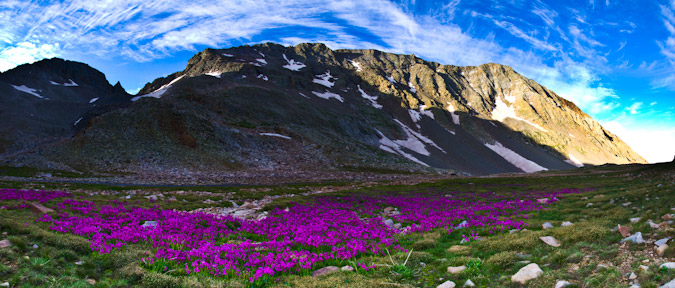
Mount Wilson is easily one of the most challenging 14ers in Colorado to climb - the standard route, while mostly straight-forward, has many difficult sections of very loose rock at the summit. The summit block itself has stopped many people in their tracks, just a few feet from the summit. The exposure there is intense and not for the feint of heart. Examples of this can be seen in my trip report from 2011. In addition to the tremendous exposure found on the summit block, Mount Wilson's approach from the Rock of Ages trailhead is fairly long and quite committing, with a lot of up-and-down climbing (unless approached from Kilpacker Basin or Navajo Basin). The difficult section of climbing found on the upper 1/3 of the route is difficult to negotiate and offers many challenges for climbers of all levels. The rock on Mount Wilson is extremely loose and many people have perished on the slopes between Mount Wilson and the un-ranked beast to the west - El Diente.
| Sustained Difficulty: 10/10 | |
| Most difficult section: 9/10 | |
| Terrain: 10/10 | |
| Access: 7/10 | |
| Total: 36/40 |
#3. Little Bear Peak

Out of all of the Fourteeners, Little Bear Peak is quite possibly my least favorite and least likely to be something I'd like to repeat. The approach is terrible - either a long slog on a rocky road in hot weather or an insane jeep ride over some of Colorado's toughest jeep obstacles (OK - those are kind of awesome). My ascent in 2010 was quite memorable, notably - the infamous "Hourglass" section just about scared me to death. Many people have perished in the Hourglass over the years, including one of the most memorable deaths in the past 5 years - Kevin Hayne. The Hourglass presents some very difficult climbing, with few good hand-holds and potentially fatal ice and water sections, not to mention the hazard of frequent rockfall from above. While Little Bear Peak is very straight-forward and mostly an easy climb, the Hourglass section marks it as one of the toughest mountains around.
| Sustained Difficulty: 6/10 | |
| Most difficult section: 10/10 | |
| Terrain: 10/10 | |
| Access: 7/10 | |
| Total: 33/40 |
#4. Pyramid Peak

Pyramid Peak, while not having many known fatalities, presents some truly heinous climbing obstacles, especially in wet conditions. The rock in the Elk Mountains is notoriously loose and nasty - making it very suspect in down-climbs and even more dangerous in rain or snow. The approach to Pyramid is fairly straightforward, albeit somewhat long and committing once above tree-line. The terrain on Pyramid is steep almost the entire climb and once above tree-line the mountain demands your concentration for the duration. While Pyramid is likely one of my favorite climbs of all time, it is not for a beginner climber and should be taking quite seriously. Of course, the views from the summit are to die for.
| Sustained Difficulty: 8/10 | |
| Most difficult section: 8/10 | |
| Terrain: 9/10 | |
| Access: 6/10 | |
| Total: 31/40 |
#5. Maroon Peak

The photo above was taken from the summit of Pyramid Peak looking out across the valley at the Maroon Bells and their insane stature. The whole area is steep and impressive, which comes with some inherent dangers and difficulties. The Maroon Bells have claimed many lives through the years and are certainly some of the most dangerous mountains in America. Of particular note, the traverse between Maroon Peak and North Maroon has claimed several victims and is a force to be reckoned with. Maroon Peak is a steep monstrosity full of beauty and loose rock as well as an intricate network of rocks, spires and falling rock that a blessing and a curse. Maroon Peak holds some of Colorado's worst rock and even the most experienced climbers have been subdued by the dangerous terrain found there.
| Sustained Difficulty: 8/10 | |
| Most difficult section: 8/10 | |
| Terrain: 9/10 | |
| Access: 6/10 | |
| Total: 30/40 |
#6. Snowmass Mountain

Snowmass Mountain is usually climbed in the early months of summer, when the face of the mountain is mostly covered in snow, making for somewhat easier travel up the snow in crampons; however, the rock beneath the snow is quite loose and is constantly shifting due to erosion. Indeed, Snowmass has proved to be particularly dangerous in the past few years due to these shifting conditions and has claimed a couple lives in the past 5 years. Snowmass' upper slopes contains large white boulders that look secure but are often quite loose and came come crashing down at any moment. The approach on all routes of Snowmass requires quite a bit of travel, which increases the difficulty.
| Sustained Difficulty: 8/10 | |
| Most difficult section: 6/10 | |
| Terrain: 7/10 | |
| Access: 8/10 | |
| Total: 29/40 |
#7. Sunlight Peak
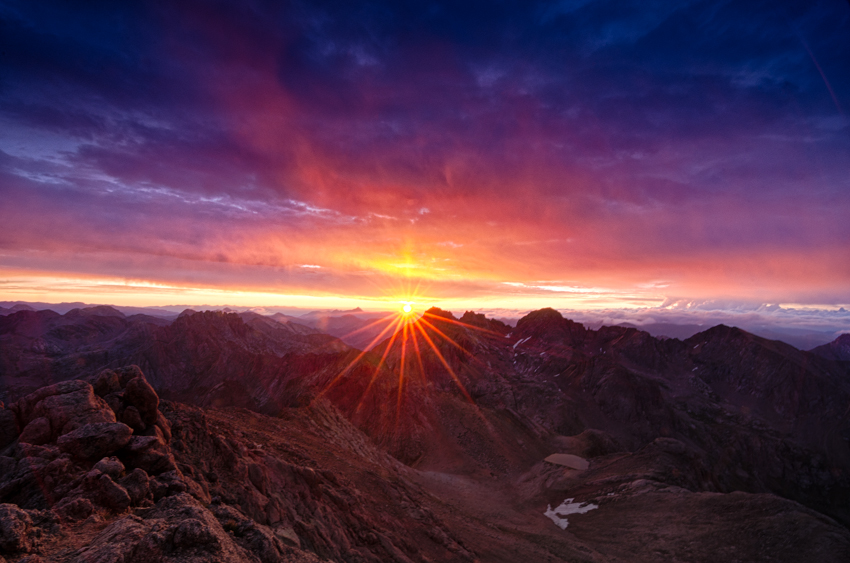
Sunlight Peak is one of the few 14ers requiring class 4 climbing to reach the summit and is generally preceded by a very long backpacking trip and a steep ascent into the Twin Lake basin. Terrain in the Chicago Basin where Sunlight resides is notoriously loose and dangerous as well as highly susceptible to frequent and quickly changing extreme weather conditions. The summit block of Sunlight presents a particularly interesting challenge for climbers and many people skip the summit block altogether if there is any moisture on the rock. Many people may rate Sunlight's next door neighbor, Windom Peak, as being the more difficult of the two; however, I personally found Sunlight to have more challenging route-finding and climbing requirements. Since Sunlight is often paired with Eolus and Windom on the same day and often as the last peak climbed, it presents even more inherent danger as many climbers attempting it are more exhausted than if doing Sunlight on its own.
| Sustained Difficulty: 7/10 | |
| Most difficult section: 8/10 | |
| Terrain: 6/10 | |
| Access: 8/10 | |
| Total: 29/40 |
#8. Crestone Needle

Coming in at number 8 on my list of Colorado's most difficult 14ers to climb is the venerable, impressive and just-plain-freaking-awesome Crestone Needle - my favorite 14er of all. The standard route of Crestone Needle brings you up a steep approach and then plants you right in a series of difficult route-finding challenges and some of the steepest yet most solid rock there is. Even though the rock is quite solid and sturdy, make no mistake - an error in judgement would likly prove fatal, especially in severe weather conditions. Indeed, Crestone Needle has claimed many lives and is a surely one of the most dangerous peaks in the Sangre de Cristo Range. Most approachs require a backpack trip or a very early start and once above tree-line the terrain is quite extreme.
| Sustained Difficulty: 7/10 | |
| Most difficult section: 7/10 | |
| Terrain: 9/10 | |
| Access: 5/10 | |
| Total: 28/40 |
#9. Longs Peak
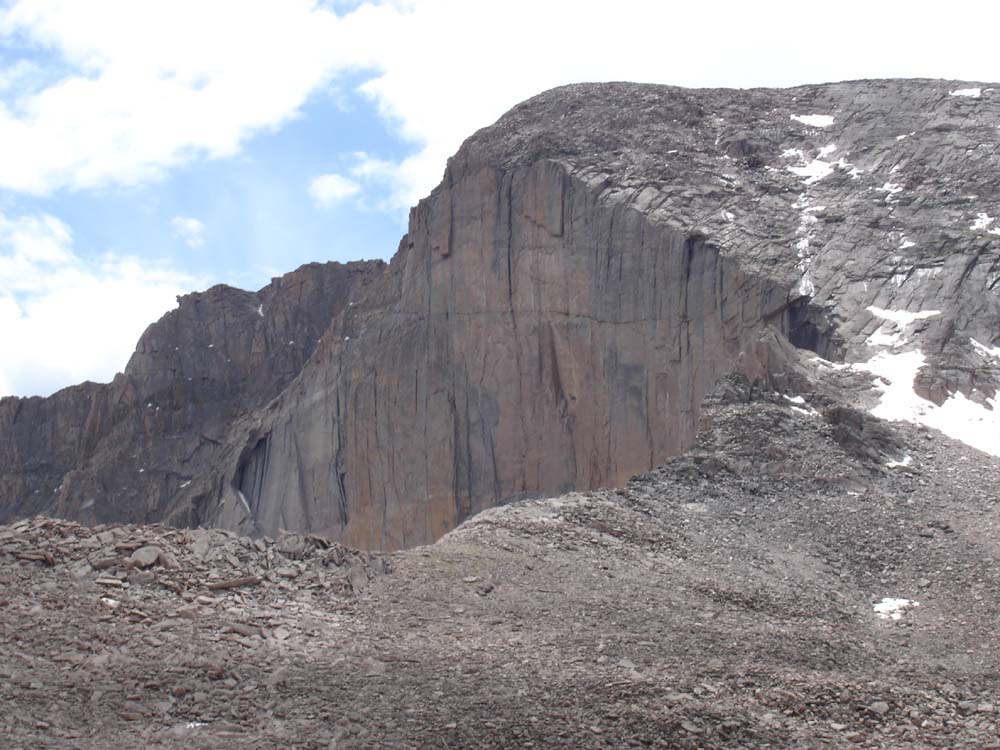
Longs Peak, located within the heart of Rocky Mountain National Park, is likely Colorado's most frequently visited mountain other than perhaps Greys and Torreys. This mountain's location in a National Park makes it a very popular destination by people from all over the world and it often lures inexperienced climbers on its more dangerous upper sections where people find themselves ill-equipped to complete the climb, both mentally and physically. Perhaps the most notable part of Longs Peak's approach is the sheer length of the climb, a full-day affair to be sure. A simple google search of Longs Peak deaths will just tell you how dangerous this peak really is, especially on the upper areas such as the Narrows and the Trough. Additional hazards plaguing this peak are the frequent deposits of snow and ice early and late in the climbing season that often contribute to the dangerous nature of the climb.
| Sustained Difficulty: 9/10 | |
| Most difficult section: 6/10 | |
| Terrain: 8/10 | |
| Access: 5/10 | |
| Total: 28/40 |
#10. Kit Carson Mountain
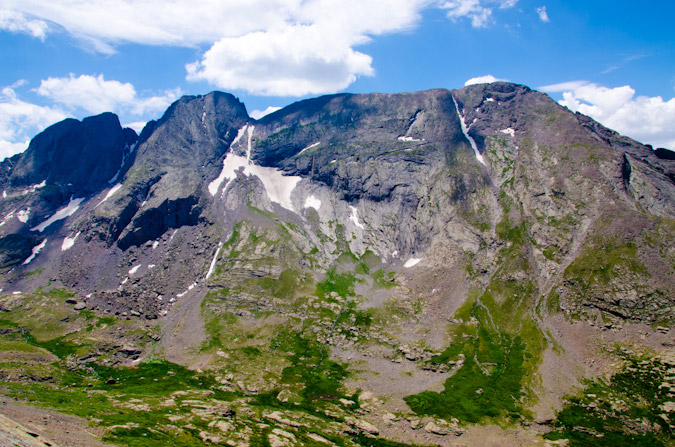
Kit Carson Mountain is one of the Sangre de Cristo giants located right by Crestone Peak and Crestone Needle. The approach to Kit Carson's standard route involves a lengthy backpacking trip and an ascent over the less impressive, albeit quite steep 14er, Challenger Point. The steep approach, coupled with a downclimb mired in confusion and difficult route-finding, makes Kit Carson quite eligible for this list. Several climbers have perished on Kit Carson in recent years, almost always due to off-route climbing.
| Sustained Difficulty: 8/10 | |
| Most difficult section: 6/10 | |
| Terrain: 6/10 | |
| Access: 7/10 | |
| Total: 27/40 |
#11. Mount Eolus
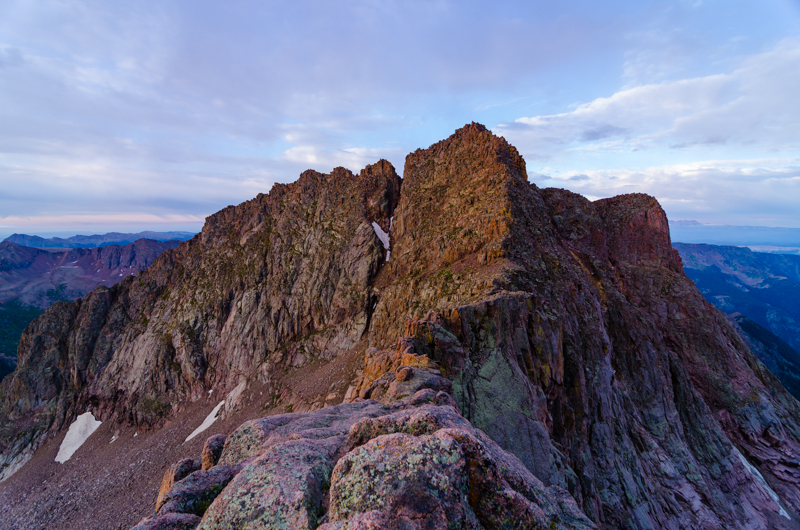
Mount Eolus marks the second of the Chicago Basin 14ers to make this list and arguably the more difficult of the three, despite my lower rating here. Eolus' "Catwalk" and steep, confusing route on the upper third of the mountain make it a top contender. The approach for Eolus is quite taxing as well and many climbers reaching the upper sections of Eolus find themselves out of energy and weakened - a terrible combination when paired with the rugged and loose terrain of the San Juan Mountains.
| Sustained Difficulty: 6/10 | |
| Most difficult section: 7/10 | |
| Terrain: 6/10 | |
| Access: 8/10 | |
| Total: 27/40 |
#12. Crestone Peak
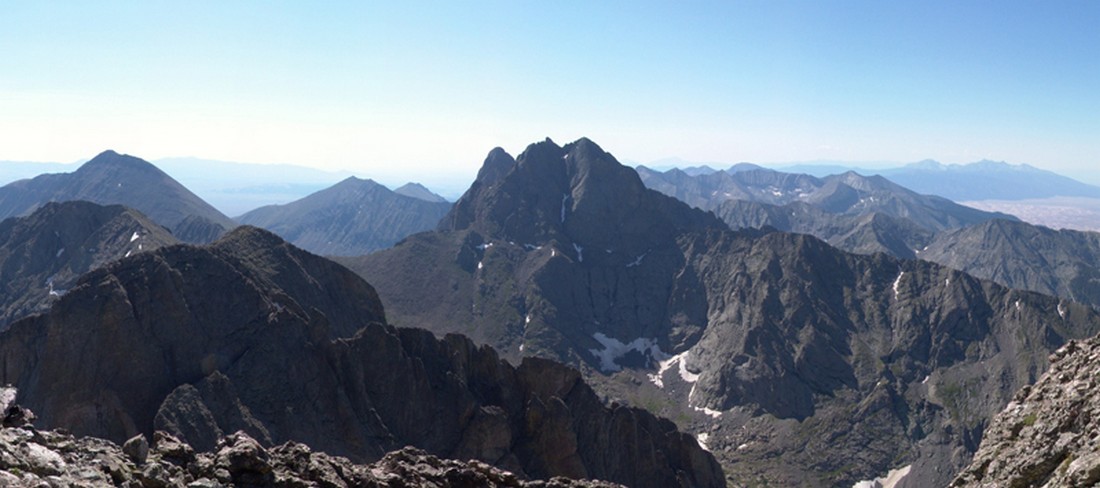
Crestone Peak has single-handedly claimed many climbers' lives over the past several years due to the loose and difficult terrain found on the upper sections of the mountain. While the mountain's standard route is mostly straight-forward, there are certainly sections that demand one's full attention and good climbing skills in order to ensure a successful summit. Like Crestone Needle, Crestone Peak's approach is a very long day up very steep trails and rock formations, increasing the difficulty of this impressive peak found in the awesome Sangre de Cristo Mountains.
| Sustained Difficulty: 6/10 | |
| Most difficult section: 7/10 | |
| Terrain: 6/10 | |
| Access: 8/10 | |
| Total: 27/40 |
How did I do? Would you have rated them differently? How so? I'd love to hear your thoughts!



